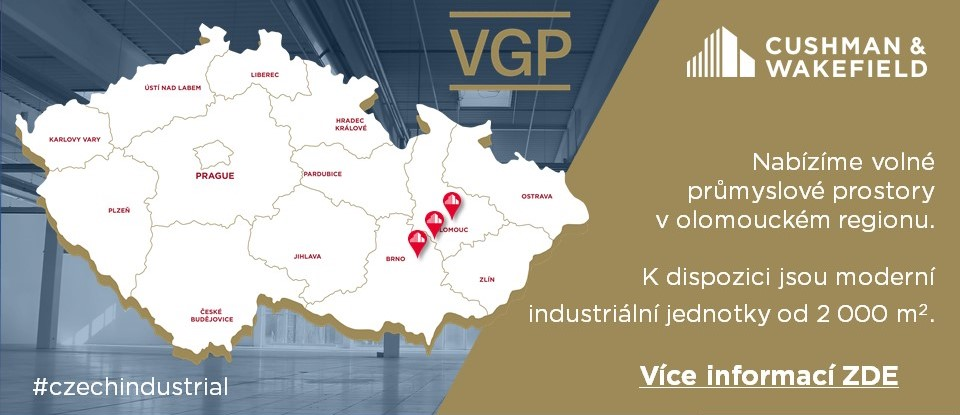 C&W | Has the Czech industrial property market reached its peak?
C&W | Has the Czech industrial property market reached its peak?
20.03.2024 v 10:40

• In most parameters the market development slowed down last year
• However, the values are still favourable, the market is doing well
• It is a return to normal rather than a deterioration
• There has been a decline across the region, with the Czech Republic still having the lowest vacancy rate and the most space per capita
PRAGUE, 20th March 2024 – The Czech industrial market‘s development slowed down to some extent last year after years of growth, but it is rather returning to normal after the record activity of 2021 and 2022. 2023 saw industrial and logistics vacancy rates double year-on-year to 1.8%, with total demand down 31% year-on-year. Construction of new halls slowed down compared to 2022 and rents grew only slightly by 3% year-on-year. However, the Czech Republic is doing well within the CEE region : the market slowdown is occurring in all CEE countries and vacancy is the lowest in the Czech Republic, which also has the most space per capita. A detailed overview of the industrial market in the Czech Republic is offered by the new interactive industrial map of the real estate consultancy Cushman & Wakefield.
Czechia: one fifth of the CEE area and the lowest vacancy rate
The total area of industrial (i.e. manufacturing and logistics) space in the CEE region at the end of 2023 was almost 61.5 million sq m. The Czech Republic accounts for 19% of this area, i.e. 11.7 million sq m. In terms of per 1,000 inhabitants, we have 1,104 sq m of such space, the highest number in the region.
Industrial halls in the Czech Republic continue to be very well occupied: the vacancy rate has been around 1% in recent years, rising slightly to 1.8% at the end of last year - this still being a very good ratio and the best result among the countries compared.
Jiří Kristek, Head of the Industrial and Retail Warehousing Team, Cushman & Wakefield:
"The reason for the increase in vacancy in the Czech Republic is mainly due to the correction of certain sectors which, after rapid growth, are experiencing stagnation or even decline, as can be very well observed, for example, in the e-commerce segment. Other causes may be the streamlining of warehousing processes, the merging of multiple warehouses into one location or the transfer of capacity to other countries."
Less construction than last year
The volume of newly completed industrial space in the Czech Republic fell slightly year-on-year last year, but 2022 was a record year in this respect. In a long-term comparison, with 921 thousand sq m last year, we are still above the ten-year and five-year average (623 and 722 thousand sq m respectively). Other CEE countries, except Hungary and Bulgaria, also recorded a year-on-year decline in construction last year.
There was also less space under construction in the Czech Republic at the end of the fourth quarter of last year than in the previous year - 981 thousand sq m. However, similarly to the space completed, the figure is still above the long-term and five-year average (550 and 752 thousand sq m respectively), and most countries in the region, except Slovakia and Romania, recorded a decline. The largest volume of construction is taking place in Poland, but even there the amount of space under construction has been gradually decreasing since 2021.
Demand fell by a third
Gross realised demand for industrial space fell year-on-year in most countries in the region last year, with the Czech Republic showing the largest drop of 31%.
Jiří Kristek, Head of the Industrial and Retail Warehousing Team, Cushman & Wakefield: "The significant drop in demand is mainly due to its unusually high volume in 2021 and 2022, when the market reacted to the increase in e-commerce related to the pandemic. However, compared to the five-year average in the pre-covid period, 2023 demand is still higher: 1.52 million sq m compared to 1.46 million sq m in 2015 to 2019. It is therefore a return to normal from previous extremes rather than a decline."
In the record years of 2021 and 2022, e-commerce accounted for 10% of gross realised demand, compared to less than 3% last year. It seems that this segment has already reached its peak, and so its need for warehouse space will be rather stagnant in the future, depending on retail demand from end consumers.
Rents rose only slightly
The two largest industrial markets in CEE have seen very strong increases in prime rents over the last five years: 71% in Poland and as much as 82% in the Czech Republic. However, last year rental growth already slowed down in the Czech Republic, with rents reaching EUR 7.75 per sq m per month, an increase of only 3% year-on-year.
Jiří Kristek, Head of the Industrial and Retail Warehousing Team, Cushman & Wakefield: "In Poland, for example, rent growth is still significant, most recently by 20%. This is because the market there had been at very low levels for a long time, mainly due to strong expectations for investment property appreciation, low construction costs and different building standards, sufficient supply of land and a simpler permitting process."
The Czech market remains attractive and promising
The Czech industrial property market is now set to stabilise. However, it is still a very healthy sector within the commercial real estate industry. Demand is gradually changing, remaining strong in logistics, with interest from manufacturing companies newly interested in locating their operations in our region. Typically, these are plants that need skilled labour and thus offer interesting jobs. Companies are looking around for regions where similar facilities are already in operation and they can build on them. In terms of demand, these are areas that are close to the final markets (Germany, Austria), or traditionally the north of Moravia.
From the investors' point of view, industrial properties are an attractive product that can diversify the level of risk of investments into other sectors of commercial real estate. However, there are very few suitable industrial projects for investment in our country, as ownership is concentrated in the hands of long-term owners who are reluctant to sell these properties.
Jiří Kristek, Head of the Industrial and Retail Warehousing Team, Cushman & Wakefield: "A complete and up-to-date overview of the Czech industrial market is provided by the new edition of our interactive digital map, which will help commercial real estate players to navigate through the Czech Republic’s 18 main industrial zones and 219 parks and monitor how the market is evolving."
The map, with dynamic features and quarterly updates, can be obtained via the www.czech-industrial.cz website. It is also available in a printed version which Cushman & Wakefield exclusively provides to those who are interested at personal meetings, together with strategic and detailed information about tenants, size and future development of specific locations.
Source: Právo /Cushman & Wakefield

 Czech
Czech